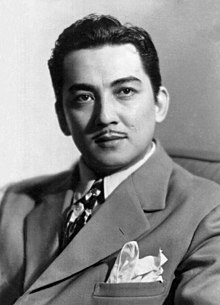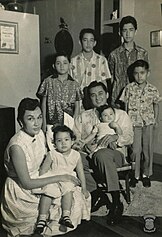Rogelio de la Rosa
This article needs additional citations for verification. (September 2015) |
Rogelio de la Rosa | |
|---|---|
 | |
| Senator of the Philippines | |
| In office December 30, 1957 – December 30, 1963 | |
| Personal details | |
| Born | Regidor Lim de la Rosa November 12, 1916 |
| Children | 7 |
| Education | Lubao Institute |
| Alma mater | Far Eastern University |
| Occupation | Actor, politician, diplomat |
Regidor Lim de la Rosa[1][2] (November 12, 1916 – November 26, 1986), professionally known as Rogelio de la Rosa, was one of the most popular Filipino matinee idols of the 20th century.[1] He is also remembered for his statesmanship, in particular his accomplishments as a diplomat. Elected to the Philippine Senate from 1957 to 1963, he was the first Filipino film actor to parlay his fame into a substantial political career, paving the way for other future Filipino entertainers-turned-politicians such as Senators Ramon Revilla Sr., Tito Sotto, Ramon "Bong" Revilla Jr., Jinggoy Estrada, Lito Lapid, Freddie Webb, Robin Padilla, and President Joseph Estrada.
Early life
De la Rosa was born in
While in high school, de la Rosa, along with Macapagal[1] would regularly perform in zarzuelas as a villain.[5]
As a teenager, he was cast by his uncle, a film director, in a starring role in the silent film Ligaw na Bulaklak opposite Rosa del Rosario. The film's director, José Nepomuceno, gave him the screen name "Rogelio de la Rosa".[6] However, the young actor did not then engage in a regular film career, opting instead to attend college at the Far Eastern University in Manila. An excellent collegiate athlete and debater in the years from 1932 to 1934. In 1933, de la Rosa won the Claro M. Recto Gold Medal in a national oratorical contest.[2]
Film stardom
De la Rosa burst into stardom in the late 1930s after being frequently cast in dramas as a romantic idol opposite such actresses as Rosa del Rosario, Carmen Rosales, Emma Alegre, and Paraluman.[7] Rosales proved to be his most durable onscreen partner, and their "love team" is said to be among the most successful in the history of Philippine movies.[7]
When the Philippine film industry was held to a standstill during the Japanese occupation from 1941 to 1945, de la Rosa remained in the public eye as a
By 1948, he was the highest paid Filipino movie actor.
Political career
As a senator
In the
Presidential candidate
After three years in the Senate, de la Rosa decided to run for the presidency as an independent candidate. His residual popularity as a film star, as well as the unpopularity of incumbent re-electionist
Shortly before election day, de la Rosa withdrew from the election at a studio in
Diplomat and later years

De la Rosa remained in public service as an acclaimed diplomat. In 1965, he was appointed Philippine Ambassador to
After retiring from the diplomatic corps, De la Rosa made his last foray into politics by unsuccessfully running in the 1984
De la Rosa was married twice. His second wife, Lota Delgado, was a former leading lady of his in films. He was buried in Loyola Memorial Park in Marikina, beside his brother's grave.[citation needed]

Selected filmography
- 1930: Bago lumubog ang araw
- 1932: Ligaw na Bulaklak
- 1932: Tianak
- 1932: Ulong Inasnan
- 1933: Nahuling Pagsisisi
- 1933: Ang Ganid
- 1934: Sawing Palad
- 1934: Krus na Bato
- 1936: Buhok ni Ester
- 1936: Diwata ng Karagatan
- 1936: Kalupitan ng Tadhana
- 1936: Awit ng mga Ulila
- 1936: Anak-Dalita
- 1936: Lagablab ng Kabataan
- 1937: Anak ng Pari
- 1937: Magkapatid
- 1937: Teniente Rosario
- 1937: Bituing Marikit
- 1938: Mga Sugat ng Puso
- 1938: Makiling
- 1938: Bukang Liwayway
- 1938: Ang Magmamani - Luis
- 1938: Sanggumay
- 1938: Bahay-Kubo
- 1938: Diwata ng Karagatan
- 1939: Magkaisang Landas
- 1939: Lagot Na Kuwintas
- 1939: Pasang Krus
- 1939: Takip-Silim
- 1939: Inang Mahal
- 1939: Florante at Laura
- 1939: Dalisay
- 1939: Ang Magsasampaguita
- 1940: Lambingan
- 1940: Senorita
- 1940: Nang Mahawi ang Ulap
- 1940: Gunita
- 1940: Diwa ng Awit
- 1940: Colegiala
- 1940: Magbalik ka, Hirang
- 1940: Katarungan
- 1940: Estrellita
- 1941: Tampuhan
- 1941: Tarhata
- 1941: Panambitan
- 1941: Ang Maestra
- 1941: Serenata sa Nayon
- 1942: Caballero
- 1942: Anong Ganda Mo
- 1944: Perfidia
- 1946: Tagumpay
- 1946: Garrison 13
- 1946: Ang Prinsipeng Hindi Tumatawa
- 1946: Dalawang Daigdig
- 1946: Honeymoon
- 1946: Victory Joe
- 1946: Angelus
- 1947: Ang Lalaki
- 1947: Ang Himala ng Birhen sa Antipolo
- 1947: Sarung Banggi - Nanding
- 1947: Hagibis
- 1947: Backpay
- 1948: Ang Vengador
- 1948: Hampas ng Langit
- 1948: Sa Tokyo Ikinasal - Carlos
- 1948: Bulaklak at Paruparo
- 1949: Kampanang Ginto
- 1949: Bandilang Basahan
- 1949: Camelia
- 1949: Kidlat sa Silangan
- 1949: Ang Hiwaga ng Tulay na Bato
- 1949: Ang Lumang Bahay sa Gulod
- 1949: Milyonarya - Delfin Glorioso
- 1950: 48 Oras - Ricardo
- 1950: Doble Cara
- 1950: Prinsipe Amante - Rodrigo
- 1950: Tigang na Lupa
- 1950: Sohrab at Rustum
- 1950: Ang Kampana ng San Diego
- 1951: Bayan o Pag-ibig
- 1951: Prinsipe Amante sa Rubitanya
- 1951: Haring Cobra - Felipe / Haring Cobra
- 1952: Dimas: The Sainted Robber - Dimas
- 1952: Romansa sa Nayon
- 1952: Babaeng hampaslupa
- 1952: Irisan
- 1953: Sa Paanan ng Bundok - Ric
- 1954: Maala-Ala Mo Kaya? - Celso
- 1954: Dakilang Pgpapakasakit - Roberto
- 1954: Jack & Jill - Gardo
- 1954: Ikaw ang Buhay Ko
- 1954: Aristokrata
- 1955: Ang Tangi kong Pag-ibig
- 1955: El conde de Monte Carlo
- 1955: Higit sa Lahat[14] - Roberto
- 1955: Sonny Boy
- 1955: Iyung-Iyo
- 1955: Pandanggo ni Neneng
- 1955: Artista
- 1956: Lydia
- 1956: Apat na Kasaysayang Ginto - (First segment -"Ngayon at Kailan Man")
- 1956: Babaing Mandarambong
- 1956: Idolo
- 1956: Pampanggenya
- 1956: Gintong Pangarap
- 1957: Veronica
- 1957: Sino ang Maysala
- 1961: Dugo at Luha - (final film role)
Notes
- ^ The Philippines was a unincorporated territory of the United States known as the Philippine Islands at the time of De la Rosa's birth.
References
- ^ a b c Garcia, J., A Movie Quizbook, p. 107.
- ^ a b "Filipinos in History Vol. 3", page 75.
- ^ "The Philippine Presidency Project - Diosdado Macapagal". Archived from the original on March 3, 2009. Retrieved October 31, 2007.
- ^ "Jaime de la Rosa, matinee idol of the 50s | the Manila Bulletin Newspaper Online". www.mb.com.ph. Archived from the original on March 18, 2011. Retrieved January 17, 2022.
- ^ a b c "Filipinos in History Vol. 3", page 76.
- ^ Garcia, J., A Movie Quizbook, pp. 108-109
- ^ a b c Garcia, J., A Movie Quizbook, p. 109.
- ^ Garcia, J., "A Movie Quizbook, p. 110
- ^ HOURS OF WATER. (June 17, 1956). South China Sunday Post - Herald
- ^ a b "Star Studded Politics". Philippine Center for Investigative Journalism. Retrieved October 31, 2007.
- ^ Macapagal's first wife and de la Rosa's sister, Purita, died in 1942, and Macapagal remarried after the war.
- ^ "Rogelio de la Rosa - Philippine Senate Website". Senate of the Philippines. Retrieved October 31, 2007.
- ^ a b "Filipinos in History Vol. 3", page 77.
- ^ Received FAMAS Best Actor Award
Sources
- Filipinos in History Vol. III. Manila, Philippines: National Historical Institute. 1996. pp. 75–77.
- Garcia, Jessie B. (2004). A Movie Album Quizbook. Iloilo City, Philippines: Erehwon Books & Magazine. pp. 202–203. ISBN 971-93297-0-X.
